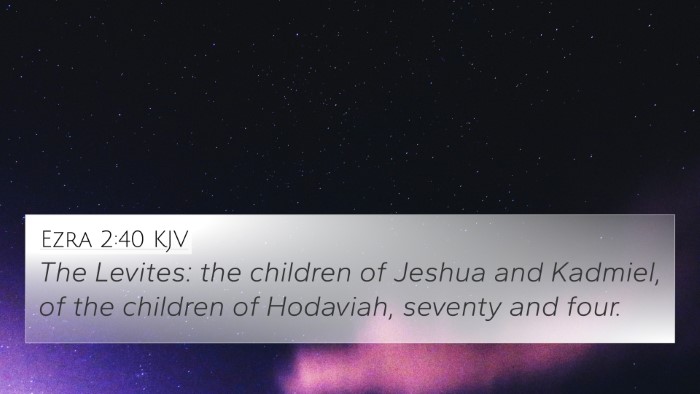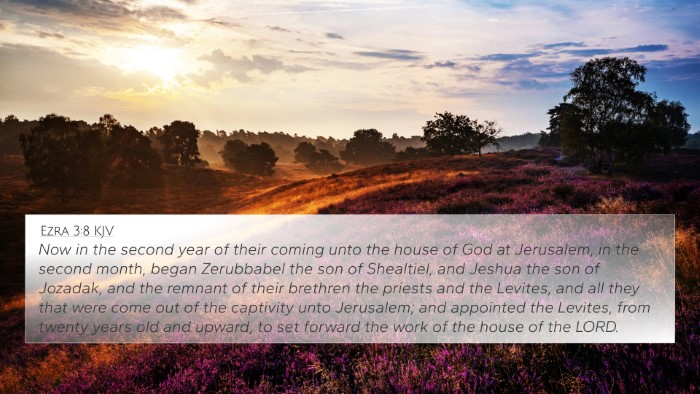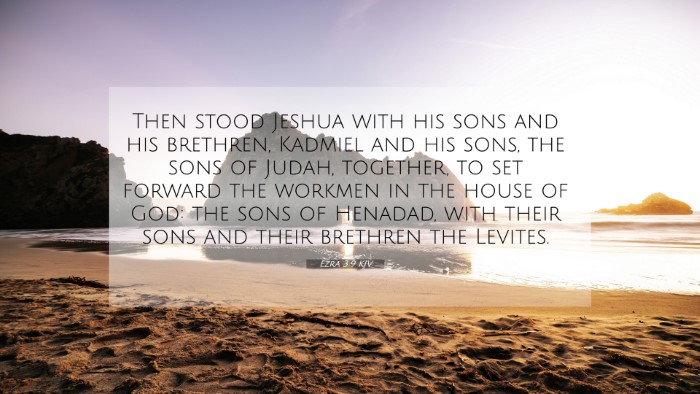Old Testament
Genesis Exodus Leviticus Numbers Deuteronomy Joshua Judges Ruth 1 Samuel 2 Samuel 1 Kings 2 Kings 1 Chronicles 2 Chronicles Ezra Nehemiah Esther Job Psalms Proverbs Ecclesiastes Song of Solomon Isaiah Jeremiah Lamentations Ezekiel Daniel Hosea Joel Amos Obadiah Jonah Micah Nahum Habakkuk Zephaniah Haggai Zechariah MalachiEzra 3:9 Similar Verses
Ezra 3:9 Cross References
Then stood Jeshua with his sons and his brethren, Kadmiel and his sons, the sons of Judah, together, to set forward the workmen in the house of God: the sons of Henadad, with their sons and their brethren the Levites.
Uncover the Rich Themes and Topics of This Bible Verse
Listed below are the Bible themes associated with Ezra 3:9. We invite you to explore each theme to gain deeper insights into the Scriptures.
Ezra 3:9 Cross Reference Verses
This section features a detailed cross-reference designed to enrich your understanding of the Scriptures. Below, you will find carefully selected verses that echo the themes and teachings related to Ezra 3:9 KJV. Click on any image to explore detailed analyses of related Bible verses and uncover deeper theological insights.

Ezra 2:40 (KJV) »
The Levites: the children of Jeshua and Kadmiel, of the children of Hodaviah, seventy and four.

Ezra 3:8 (KJV) »
Now in the second year of their coming unto the house of God at Jerusalem, in the second month, began Zerubbabel the son of Shealtiel, and Jeshua the son of Jozadak, and the remnant of their brethren the priests and the Levites, and all they that were come out of the captivity unto Jerusalem; and appointed the Levites, from twenty years old and upward, to set forward the work of the house of the LORD.

Nehemiah 7:43 (KJV) »
The Levites: the children of Jeshua, of Kadmiel, and of the children of Hodevah, seventy and four.
Ezra 3:9 Verse Analysis and Similar Verses
Ezra 3:9 - Interpretation and Meaning
Verse: "Then stood Jeshua with his sons and his brethren, Kadmiel and his sons, the sons of Judah, together, to set forward the workmen in the house of God: the sons of Henadad, with their sons and their brethren, the Levites." (Ezra 3:9)
Contextual Overview
The book of Ezra recounts the return of the Jewish exiles from Babylon to Jerusalem and the rebuilding of the Temple. Ezra 3:9 introduces a pivotal moment in this rebuilding effort, highlighting the leadership and organizational structure necessary for the work ahead. The verse underscores the unity and cooperation among the leaders in advancing the mission of restoring the worship of God in Jerusalem.
Key Themes
- Leadership: Jeshua serves as a pivotal leader in the restoration efforts, showing the importance of strong leadership in community projects.
- Cohesion Among Leaders: The collaboration among Jeshua, Kadmiel, and the Levites reflects the necessity of teamwork in fulfilling divine purposes.
- The Role of the Levites: The mention of the Levites emphasizes their specialized role in temple service and the maintenance of worship practices.
Commentary Insights
Matthew Henry: Henry notes the significance of the gathering of leaders in this verse. He emphasizes that the roles of Jeshua and Kadmiel illustrate the importance of leadership and motivation in spiritual tasks. Their families participated, indicating that spiritual commitment can often be a family affair, which sets a precedent for future generations in their faith.
Albert Barnes: Barnes highlights the organizational aspect of the verse. He points out that the workmen were not just called to labor but were organized for a purpose, stressing the importance of structure in undertaking the restoration of God’s house. This shows that God’s work requires not just zeal but also determined planning and execution.
Adam Clarke: Clarke discusses the historical significance of the Levites and their representation in this chapter. He explains how their active participation is a return to the roots of Jewish worship and tradition, linking it to God’s original instruction concerning temple service. He comments on the generational transmission of responsibility and faithfulness in God’s work.
Bible Cross-References
This verse is connected to several significant biblical passages that further elucidate its meaning:
- Nehemiah 12:8: Highlights the role of singers and Levites in the service of the Temple.
- 1 Chronicles 9:10-13: Provides insight into the lineage and duties of the Levites and priests.
- Ezra 2:70: Discusses the roles of everyone involved in the restoration of the Temple.
- Haggai 1:1: Calls attention to the prophet Haggai's encouragement to rebuild the house of God.
- Zechariah 3:1-10: Describes the restoration of Joshua, the high priest, paralleling the themes of divine favor and leadership.
- Exodus 28:1: Discusses the anointing of Aaron and his sons as priests, connecting to themes of divine service.
- 2 Chronicles 34:3-4: Relates to King Josiah’s reforms and the restoration of the Temple, serving as a historical parallel.
Understanding the Connections
The connections between Bible verses throughout scripture form a rich tapestry that enhances our understanding of God’s work through history. For instance:
- The leadership roles in Ezra 3:9 foreshadow the leadership seen in Nehemiah’s rebuilding efforts post-exile.
- The theme of restoration resonates with New Testament themes of renewal and the church's mission (e.g., Matthew 28:19-20).
- Linking the responsibilities of the Levites in Ezra with those in the Gospels reveals continuity in God’s plan for worship.
Cross-Referencing Themes
Utilizing tools for Bible cross-referencing can illuminate these themes further. For example:
- Scriptural cross-referencing can reveal how Ezra’s narrative informs Christian worship practices today.
- Comparative Bible verse analysis might focus on how Ezra's rebuilding parallels the New Testament’s emphasis on constructing a spiritual house (1 Peter 2:5).
- Inter-Biblical dialogue through these connections offers a holistic understanding of God's covenant with His people.
Conclusion
In summarizing Ezra 3:9, we see a profound example of structured leadership, collective effort, and the continuation of God’s covenant through His people. Each character and group mentioned serves a purpose in God’s divine plan, echoing throughout scripture. By exploring these cross-references and utilizing Bible reference resources, believers can deepen their understanding of God’s overarching narrative and their place within it.


